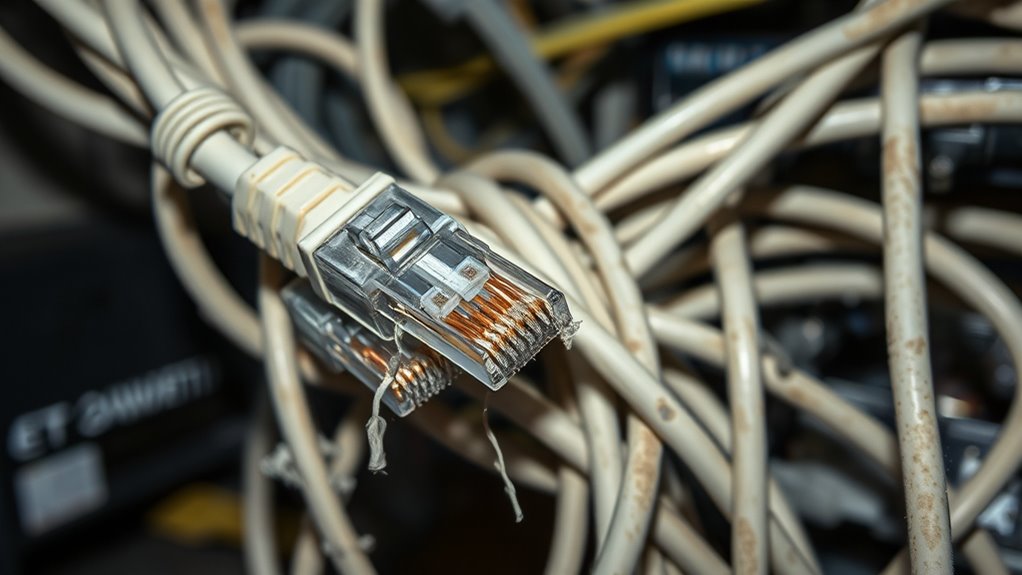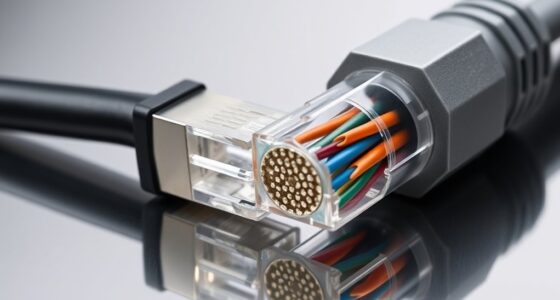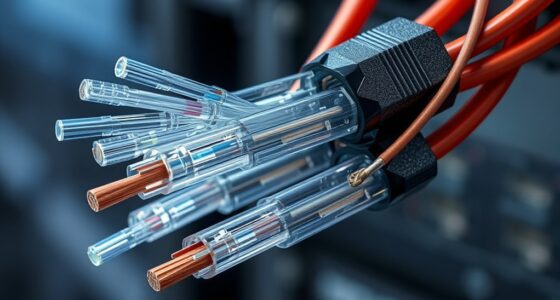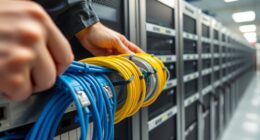As someone responsible for your network infrastructure, you’ve likely noticed that Cat5e cabling no longer meets the demands of modern technology. Its limited bandwidth and slower speeds can create bottlenecks, especially with data-intensive applications. But what’s next? Understanding why Cat5e is reaching the end of its life can help you make smarter decisions for upgrades that keep your organization ahead. The reasons behind this shift might surprise you.
Key Takeaways
- Cat5e cabling no longer supports the high speeds and bandwidth required for modern applications.
- Its performance limits cause network congestion and slow data transfer rates.
- Aging infrastructure increases maintenance costs and reliability issues.
- Newer technologies like fiber optics and Wi-Fi outperform Cat5e in speed and stability.
- Upgrading ensures future-proof, scalable, and more efficient network connectivity.
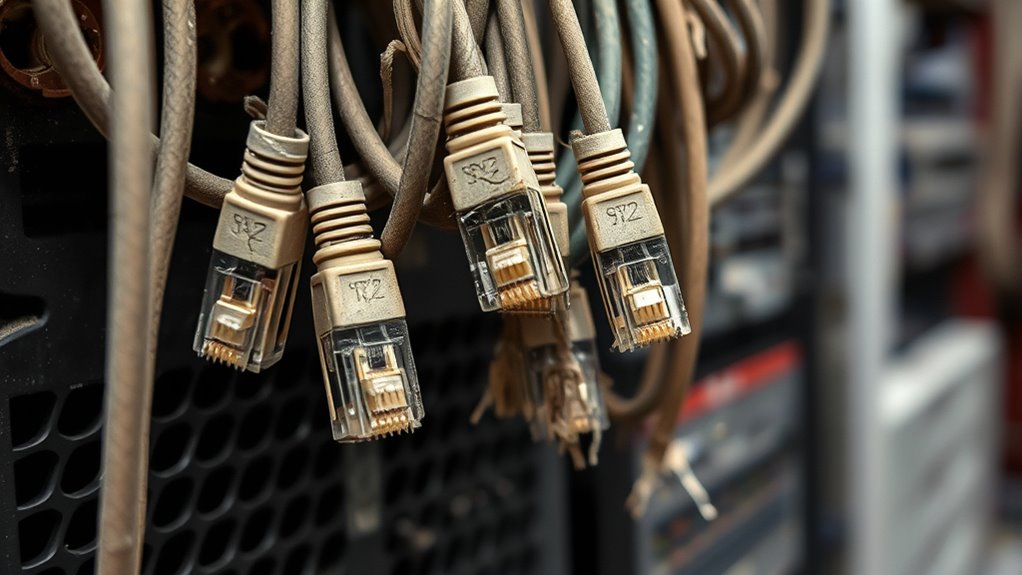
As technology advances, many organizations are beginning to phase out Cat5e cabling, signaling its end of life. This shift is driven by the need for faster, more reliable network connections that can support modern applications. While Cat5e has served well for years, it’s reaching its limits in terms of speed and bandwidth. Today’s data-intensive tasks, like streaming high-definition content or managing large data transfers, demand higher performance, which Cat5e simply can’t sustain anymore. That’s where fiber optic solutions come into play, offering considerably faster speeds and greater capacity over longer distances. Fiber optic cables use light to transmit data, making them immune to electromagnetic interference and ensuring a more stable connection. As organizations look to future-proof their networks, fiber optic is becoming the standard, replacing traditional copper cables like Cat5e.
As organizations seek faster, more reliable connections, fiber optic is replacing Cat5e for greater speed and capacity.
In addition to fiber optic, wireless technology is transforming how we connect to networks. Wireless solutions provide the flexibility and convenience that wired connections, including Cat5e, can’t match. With advancements in Wi-Fi standards, such as Wi-Fi 6 and upcoming Wi-Fi 7, users can enjoy faster speeds, lower latency, and improved reliability without the need for extensive cabling. This shift toward wireless connectivity means that organizations can reduce their dependency on physical cables, simplify installation, and support a more mobile workforce. As wireless technology continues to evolve, it becomes even more attractive compared to aging wired infrastructure. Moreover, high-quality cabling can still be essential in certain environments where wireless signals are obstructed or unreliable.
The growing demand for higher bandwidth and faster speeds makes Cat5e infrastructure increasingly obsolete. While it was once a reliable choice for small networks and basic internet use, it can’t keep up with the demands of today’s digital environment. Network congestion and slow data transfer rates are common issues with outdated wiring, impacting productivity and user experience. Upgrading to fiber optic cables or adopting wireless technology not only improves network performance but also enhances scalability. These modern solutions support future growth, whether that means expanding your network’s capacity or integrating new devices and applications.
Ultimately, the trend toward fiber optic and wireless connectivity indicates that Cat5e is nearing the end of its usefulness. Organizations that delay upgrading risk falling behind in a competitive landscape, facing higher maintenance costs and limited capacity. By embracing these newer technologies, you can ensure your network remains robust, fast, and adaptable to the evolving digital world. The transition may require investment, but it’s essential for staying current and meeting the demands of modern business operations.
Frequently Asked Questions
What Are the Alternative Cables Replacing Cat5e?
You should consider upgrading to fiber optic cables or higher-grade twisted pair cables like Cat6 or Cat6a. Fiber optic offers much faster speeds and longer distances, ideal for future-proofing your network. Twisted pair cables like Cat6 improve bandwidth and reduce crosstalk compared to Cat5e. These alternatives guarantee your network stays reliable, scalable, and ready for the demands of modern data transmission.
How Does Cat6 Compare to Cat5e in Performance?
Sure, upgrading to Cat6 is a smart move. It outperforms Cat5e by boosting bandwidth and reducing network congestion, making your data flow smoother. Plus, it handles signal interference better, so your connection stays resilient even in crowded environments. While Cat5e is like a bicycle for your network, Cat6 is a sports car—faster, more reliable, and ready to handle the demands of modern tech. Don’t settle for less!
Can Existing Cat5e Cables Be Upgraded Easily?
Upgrading your existing Cat5e cables isn’t always straightforward due to cable compatibility and upgrade challenges. You’ll need to take into account whether your current infrastructure supports higher speeds and newer standards. Often, replacing outdated cables with Cat6 or newer options is the most reliable solution, especially if you want better performance. Keep in mind that upgrading may involve additional work like changing connectors or patch panels, so plan accordingly to avoid compatibility issues.
What Are the Cost Differences Between Cat5e and Newer Cables?
You’ll find that the cost comparison between Cat5e and newer cables like Cat6 or Cat6a varies, but generally, newer cables are about 20-30% more expensive per foot. With a typical installation, this budget impact can add up quickly, especially for large projects. While upgrading costs more upfront, investing in higher-grade cables can improve network performance and future-proof your setup, saving you money in the long run.
How Does Cable Lifespan Vary With Installation Environment?
You’ll find that cable lifespan varies greatly depending on installation challenges and environmental impacts. In harsh environments with high humidity, extreme temperatures, or exposure to chemicals, cables degrade faster and need replacing sooner. Poor installation practices, like tight bends or improper shielding, also accelerate wear. To maximize longevity, guarantee proper installation and consider environmental factors, especially when upgrading to newer cables that are designed to withstand more demanding conditions.
Conclusion
So, if you’re still clinging to that ancient Cat5e cable, it’s time to face the music. Your slow, interference-prone connection is finally giving up the ghost, just like your outdated tech choices. Upgrading to fiber or wireless isn’t just a smart move—it’s the only way to keep up with a world that refuses to wait. Don’t be that person still trying to stream 4K on a network that’s long past its prime.
